
Browse an alphabetical list of photographs. These historical images portray people, places, and events before, during, and after World War II and the Holocaust.
<< Previous | Displaying results 476-500 of 2641 for "Photo" | Next >>
View of a building that served as a dining room for the Germans and as lodgings for the camp commanders at the Sobibor killing center in German-occupied Poland.
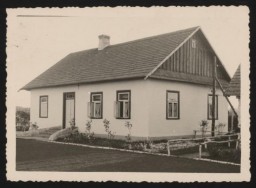
Postwar photograph of a building in Dabie where the possessions of Jews killed at the nearby Chelmno killing center were stored. Dabie, Poland, June 1945.
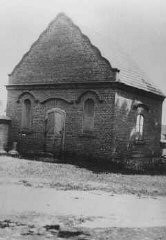
Planned as a short military revolt, the Warsaw Polish uprising lasted 63 days, from August to October 1944. In the end, German troops destroyed the majority of Warsaw during and immediately after the uprising. Photo dated January 17, 1945.
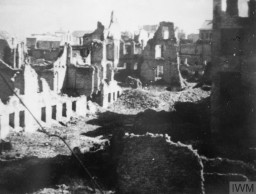
Bulgarian authorities round up Jews in occupied Macedonia for deportation. They were first held in a camp in Skopje and then deported to the Treblinka killing center in German-occupied Poland. Skopje, Yugoslavia, March 1943.
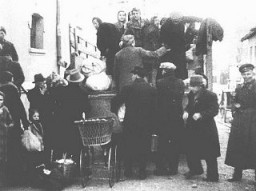
American soldiers watch as German civilians bury the corpses of prisoners found in the Dora-Mittelbau concentration camp. Nordhausen, Germany, April 13-14, 1945.
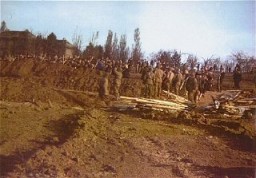
After the liberation of the Wöbbelin camp, US troops forced the townspeople of Ludwigslust to bury the bodies of prisoners killed in the camp. Germany, May 7, 1945.
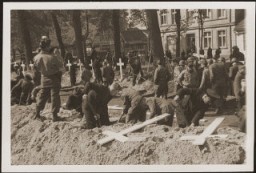
After the liberation of Dora-Mittelbau, local German residents were required to bury the bodies of victims of the camp. Dora-Mittelbau, Germany, April 13–14, 1945.
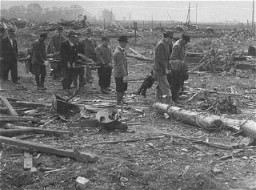
Mourners and local residents shovel dirt into the mass grave of the victims of the Kielce pogrom during the public burial.
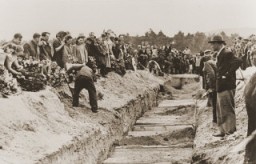
Mourners crowd around a narrow trench as coffins of pogrom victims are placed in a common grave, following a mass burial service. Kielce, Poland, after July 4, 1946.
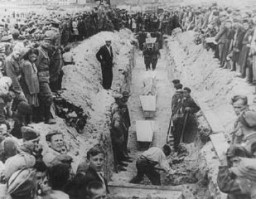
After the liberation of the camp, the US Army ordered the local townspeople to bury the corpses of prisoners killed in the camp. This photograph shows troops observing a moment of silence at a mass funeral for victims of the Wöbbelin camp. Germany, May 7, 1945.
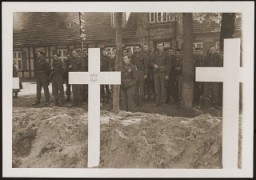
German civilians from Ludwigslust file past the corpses and graves of 200 prisoners from the nearby concentration camp of Wöbbelin. The US Army ordered the townspeople to bury the corpses on the palace grounds of the Archduke of Mecklenburg. Germany, May 7, 1945. Outraged by what they found upon entering the camp, the ranking Allied commanders in the area forced civilians from the nearby towns of Schwerin, Hagenow, and Ludwigslust to view the concentration camp and then bury the bodies of prisoners…
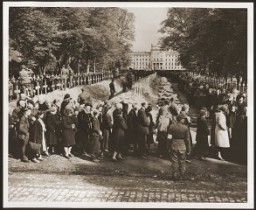
German civilians from Volary attend burial services for the Jewish women exhumed from a mass grave in the town. The victims died at the end of a death march from Helmbrechts, a subcamp of Flossenbürg. Germans were forced to exhume them in order to give the victims proper burial. Volary, Czechoslovakia, May 11, 1945.
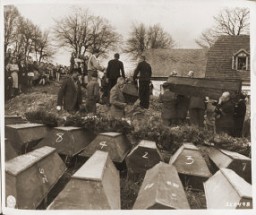
Beginning of the burning of the village of Um Zeifa in Darfur after the Janjaweed looted and attacked. Photograph taken by Brian Steidle, December 2004.
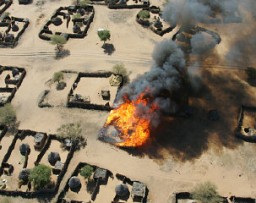
Local residents watch the burning of the ceremonial hall at the Jewish cemetery in Graz during Kristallnacht (the "Night of Broken Glass"). Graz, Austria, November 9–10, 1938.
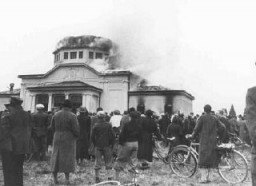
The synagogue in Oberramstadt (a town in southwestern Germany) burns during Kristallnacht. Oberramstadt, Germany, November 9-10, 1938.
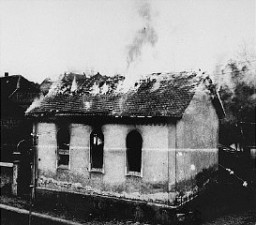
Benjamin Meed joins children in burying a time capsule during the Tribute to Holocaust Survivors: Reunion of a Special Family, one of the Museum's tenth anniversary events. Washington, DC, November 2003.
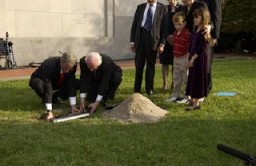
After the liberation of the Wöbbelin camp, US troops forced the townspeople of Ludwigslust to bury the bodies of prisoners killed in the camp. This photograph shows German civilians who were ordered to bury the dead; US troops stand in the background. Germany, May 7, 1945
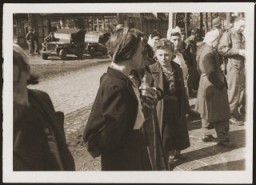
Buses that transported patients from the Eichberg hospital near Wiesbaden to the Hadamar euthanasia center, where the patients were gassed or killed by lethal injection. Germany, between May and September 1941.
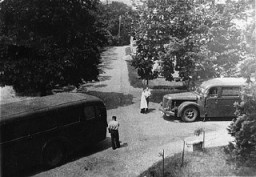
Buses used to transport patients from the Eichberg hospital near Wiesbaden to Hadamar euthanasia center. The windows were painted to prevent people from seeing those inside. Germany, between May and September 1941.

Buses waiting at the entrance to the Vélodrome d'Hiver, where almost 13,000 Jews were assembled before being transported to Drancy and other French transit camps. Paris, France, July 16 and 17, 1942.
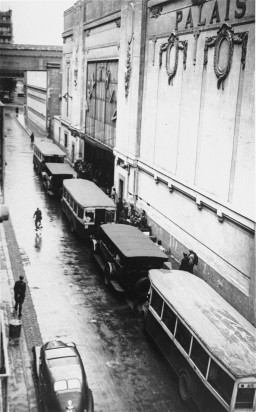
Portrait of Alfred Rosenberg. One of a collection of portraits included in a 1939 calendar of Nazi officials. Germany, 1939.
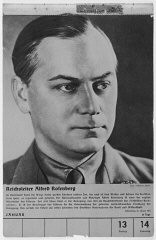
This photo shows a placard urging Hungarian Jews to unite against rising antisemitism in prewar Hungary and Europe. It rallies Jews to protest, using such phrases as: "Protect Jewish honor!”; “Do not buy from our enemies!”; and “Do not watch movies from the Third Reich." Hungary, 1937.
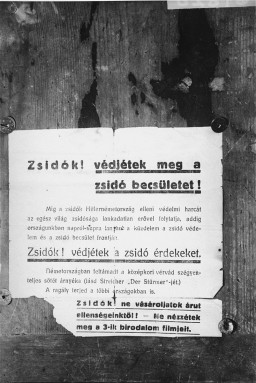
This camera equipment belonged to Walter Hunkler, a sergeant assigned to a medical detachment of the 160th Field Artillery Battalion, which entered Dachau on April 29, 1945. He took photographs documenting the camp and the prisoners found there.
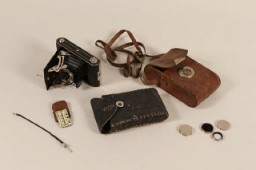
Camp commandant Amon Goeth delivers a speech to SS guards in the Płaszów camp. Płaszów, Poland, 1943-1944.

Romani (Gypsy) women boil laundry and hang it to dry in the middle of the camp at Marzahn. Germany, June 1936. Shortly before the opening of the 1936 Olympic Games in Berlin, the police ordered the arrest and forcible relocation of all Roma in Greater Berlin to Marzahn, an open field located near a cemetery and sewage dump in eastern Berlin. Police surrounded all Romani encampments and transported the inhabitants and their wagons to Marzahn.
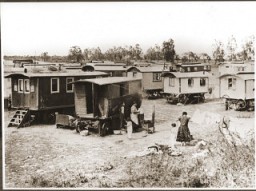
We would like to thank Crown Family Philanthropies, Abe and Ida Cooper Foundation, the Claims Conference, EVZ, and BMF for supporting the ongoing work to create content and resources for the Holocaust Encyclopedia. View the list of donor acknowledgement.